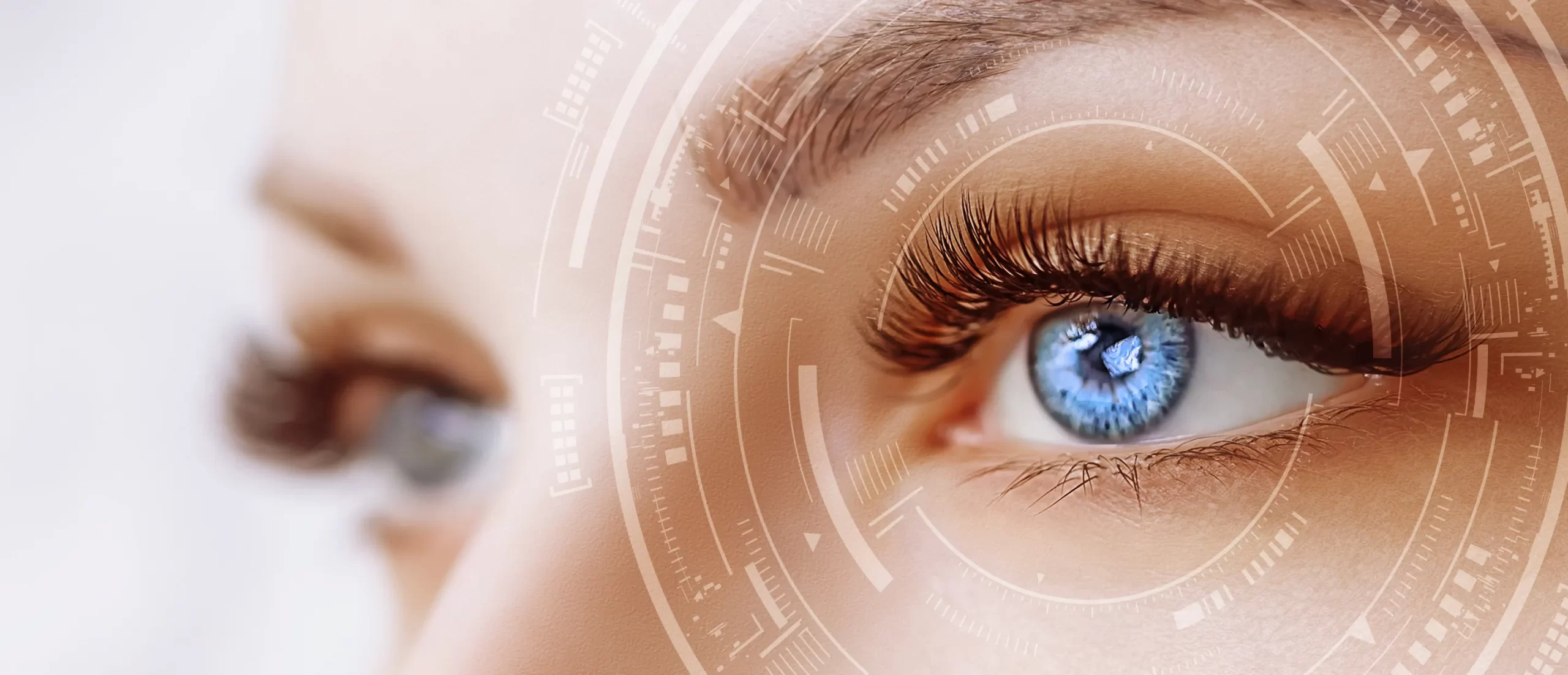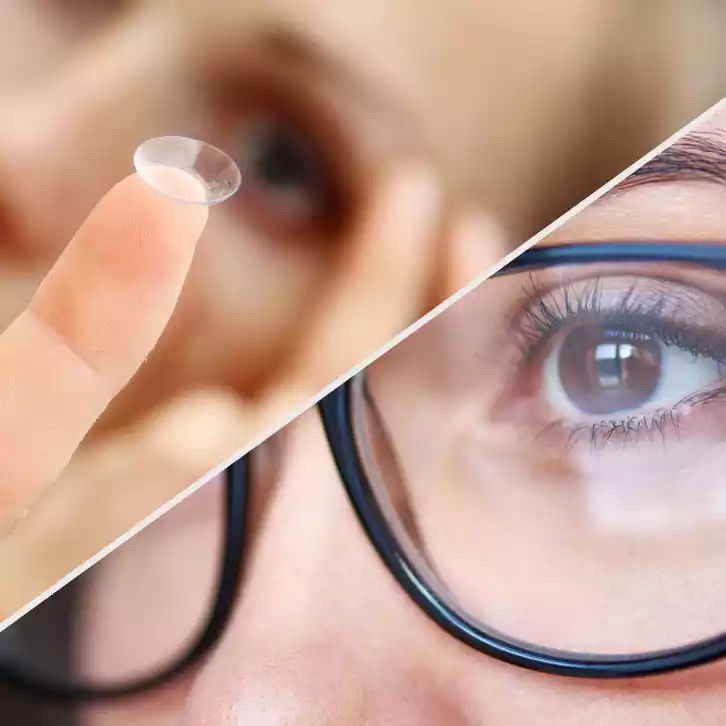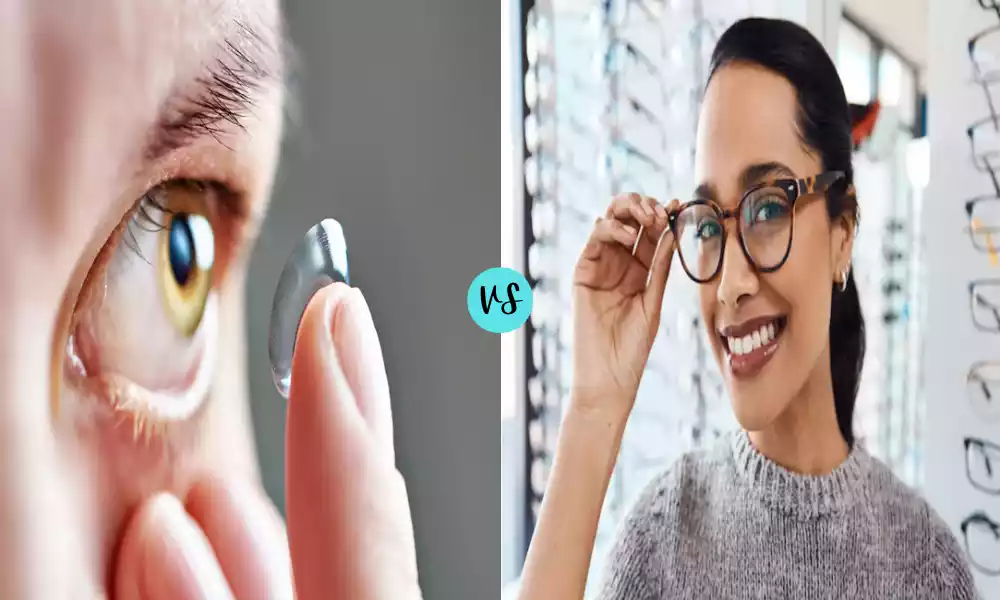Contact lenses and spectacles, both pivotal innovations in the realm of vision correction, have served generations with diverse visual needs. While spectacles, or eyeglasses, have a long-standing history, tracing back to ancient civilizations, and have evolved in design and functionality over the centuries, contact lenses are a relatively more modern invention, seamlessly fitting over the cornea to correct vision without any visible apparatus.
Each has its unique set of advantages and applications, catering to the varied preferences and lifestyles of users. Their primary objective remains the same: to enhance and correct vision, ensuring that the world is seen with clarity.
History of Vision Correction
The quest to correct and enhance human vision spans millennia, tracing back to ancient civilizations. In ancient Rome, for example, scholars peered through glass spheres filled with water to magnify and clarify texts. The evolution of vision correction took a significant turn in the 13th century in Italy, where the first rudimentary reading glasses were developed. These early spectacles, made with convex lenses to aid the farsighted, signified the beginnings of optics as a science. As the centuries progressed, so too did the sophistication of these aids.
By the 18th century, Benjamin Franklin, recognizing the need to correct both near and far vision, invented bifocals. The concept of directly altering the eye’s surface to correct vision issues emerged in the 19th century, but it wasn’t until the 20th century that technology caught up with this idea, leading to the invention of contact lenses and the advent of refractive surgeries like LASIK. Today’s vision correction methods, built on a rich tapestry of historic milestones, offer varied and advanced solutions to cater to diverse visual needs.
Definition of Contact Lenses
Contact lenses are thin, curved lenses placed directly on the surface of the eye to correct visual impairments. Made from various materials, including soft polymers and rigid plastics, they are designed to fit the contour of the cornea and float on the tear film. Contact lenses serve the same purpose as eyeglasses—to refract and focus light onto the retina, thereby clarifying vision.

They can correct a range of refractive errors, such as myopia (nearsightedness), hypermetropia (farsightedness), astigmatism, and presbyopia. In addition to vision correction, contact lenses can also be worn for cosmetic purposes, such as changing one’s eye color. Proper care and hygiene are essential when using contact lenses to prevent eye infections and ensure comfort.
Types of Contact Lenses
Contact lenses come in a variety of types, designed to fit different lifestyles, vision problems, and wearer preferences. Here’s an overview of the major types of contact lenses:
- By Material:
- Soft Lenses: Made of soft, flexible plastics that allow oxygen to pass through to the cornea. They are easier to adjust to and tend to be more comfortable than rigid lenses.
- Hydrogel Lenses: Traditional soft lenses.
- Silicone Hydrogel Lenses: Advanced type, allowing even more oxygen to pass through.
- Rigid Gas Permeable (RGP) Lenses: Hard lenses that allow oxygen to pass through. They offer sharp vision and correct most vision problems.
- Hybrid Contact Lenses: Combine features of both soft and RGP lenses. They have a rigid center and a soft periphery, designed to provide the clarity of RGP lenses with the comfort of soft lenses.
- Soft Lenses: Made of soft, flexible plastics that allow oxygen to pass through to the cornea. They are easier to adjust to and tend to be more comfortable than rigid lenses.
- By Wear Schedule:
- Daily Wear: Removed nightly and replaced on a schedule (daily, bi-weekly, monthly).
- Extended Wear: Can be worn overnight but still need to be removed at least once a week for cleaning. Some are FDA-approved for up to 30 days of continuous wear.
- Disposable (Daily Disposable): Worn once and then discarded.
- By Vision Problem:
- Spherical Lenses: For nearsightedness or farsightedness.
- Toric Lenses: Designed for astigmatism. They have different powers in different lens meridians and may have a mechanism to prevent rotation.
- Bifocal/Multifocal Lenses: For presbyopia, they have multiple zones for near and far vision.
- Orthokeratology (Ortho-K) Lenses: Rigid lenses worn overnight to reshape the cornea temporarily. They are removed during the day, and the reshaped cornea provides clearer vision.
- By Special Purpose:
- Cosmetic & Theatrical Lenses: Change the appearance or color of the eyes. Some are prescription, while others are plano (without corrective power).
- Prosthetic Lenses: Designed to cosmetically mask eye disfigurements.
- Scleral Lenses: Large-diameter rigid gas permeable lenses that rest on the sclera and create a tear-filled vault over the cornea. They’re used for certain conditions like keratoconus or severe dry eyes.
- UV-inhibiting Lenses: Provide protection against harmful UV rays.
- Therapeutic Lenses: Soft lenses used for treating non-refractive disorders of the eye.
- By Replacement Schedule:
- Daily: Discarded after one day of use.
- Weekly/Bi-weekly: Replaced every two weeks.
- Monthly: Replaced every month.
- Quarterly: Replaced every three months or as recommended.
- Annual: Replaced once a year.
When considering contact lenses, it’s essential to consult with an optometrist or ophthalmologist to determine the best fit for individual needs, ensuring optimal vision, comfort, and eye health.
Definition of Spectacles
Spectacles, commonly known as eyeglasses or glasses, are frames bearing lenses worn in front of the eyes, primarily for vision correction. The lenses are specifically tailored to an individual’s refractive error, allowing the person to see clearly by redirecting light rays to properly focus on the retina. Spectacles can correct various visual impairments, including myopia (nearsightedness), hypermetropia (farsightedness), astigmatism, and presbyopia.

Apart from their functional use, spectacles have become a notable fashion accessory, with frames available in myriad styles, colors, and materials. Some glasses also serve protective purposes, shielding the eyes from harmful UV rays or potential physical harm.
Types of Spectacles
Spectacles, commonly known as eyeglasses or glasses, come in various types to cater to different visual needs, aesthetic preferences, and lifestyles. Here’s a comprehensive overview of the primary types of spectacles:
- By Vision Correction:
- Single Vision: One corrective power across the entire lens, typically for nearsightedness (myopia), farsightedness (hypermetropia), or astigmatism.
- Bifocal: Contains two distinct sections—upper for distance vision and lower for near vision, with a visible line separating them.
- Trifocal: Contains three sections for distance, intermediate, and near vision, with two visible lines.
- Progressive (Multifocal or Varifocals): Offers multiple vision corrections, transitioning seamlessly from distance to near, without any visible lines.
- By Frame Style:
- Full Frame: Lenses are completely surrounded by the frame.
- Semi-Rimless (Half Frame): Lenses are held in place by a frame on the top half only.
- Rimless: Lenses are directly attached to the temples and bridge, with no surrounding frame.
- Wraparound: Curved frames that wrap around the head, often used for sports or sunglasses.
- By Lens Material:
- Plastic (CR-39): Lightweight and cost-effective.
- Polycarbonate: Impact-resistant and lighter than plastic, ideal for children, sports, and safety glasses.
- High-Index Plastic: Thinner and lighter than regular plastic, ideal for strong prescriptions.
- Trivex: Lightweight, impact-resistant, and clearer vision than polycarbonate.
- Glass: Heavy but offers excellent optics.
- By Lens Coating & Treatment:
- Anti-Reflective (AR): Reduces glare, reflections, and ghost images.
- Scratch-Resistant: Protects lenses from everyday wear and tear.
- UV Protection: Blocks harmful UV rays from the sun.
- Blue Light Blocking: Filters blue light, especially from digital screens.
- Photochromic: Automatically darken in sunlight and return to clear indoors.
- Tinted: Have a color tint, usually used for cosmetic reasons or sunglasses.
- Polarized: Reduces glare from reflective surfaces, ideal for driving and water activities.
- By Special Purpose:
- Reading Glasses: Over-the-counter glasses for presbyopia, designed for close-up tasks.
- Computer Glasses: Optimized for the distance from the user to the computer screen, with coatings to reduce digital eye strain.
- Safety Glasses: Protect the eyes from potential hazards, made with shatter-resistant lenses.
- Sports Glasses: Designed for specific activities, offering protection and clearer vision.
- Sunglasses: Filter out UV rays and reduce glare, available in prescription and non-prescription forms.
- By Fit & Form Factor:
- Oversized: Larger than the wearer’s face, often for fashion or extensive sun protection.
- Cat-Eye: Upswept outer corners, reminiscent of a cat’s eyes, often chosen for style.
- Aviator: Originally designed for pilots, with large teardrop-shaped lenses.
When considering spectacles, it’s advisable to consult with an optometrist or optician to determine the best type and fit for individual needs, ensuring optimal vision, comfort, and style.
Comparison Table of Contact Lenses and Spectacles
Comparison Table: Contact Lenses vs. Spectacles
| Feature | Contact Lenses | Spectacles |
|---|---|---|
| Placement | Directly on the eye’s surface | Worn in front of the eyes on a frame |
| Visibility | Virtually invisible | Visible; frames can be a fashion statement |
| Field of Vision | Wider; no frame obstruction | Can be limited by frame and lens edges |
| Adjustment Period | Might take time for some users | Generally quicker and easier |
| Maintenance | Regular cleaning with specific solutions | Cleaning with a cloth; occasional adjustments |
| Protection from Environment | Less affected by weather but can trap debris | Can fog up, get wet, but can shield from debris |
| Durability | Typically replaced daily, bi-weekly, or monthly | Longer-lasting; dependent on care |
| Cost Over Time | Recurring cost (purchase & maintenance) | Initial cost higher; longer lifespan |
| Eye Health Risk | Potential for infections if not maintained properly | Reduced direct contact, generally safer |
| Correction Range | Suitable for most visual impairments | Broad range, including bifocals and progressives |
| Cosmetic Variability | Limited to colors and some patterns | Wide range of frame styles, colors, and materials |
| Protection from UV Rays | Some offer UV protection | Can have UV-protective coatings |
| Comfort in Physical Activities | Generally stable and less cumbersome | Can slide off or become a hindrance |
This table provides a general comparison. It’s worth noting that individual experiences may vary based on the specific type of contact lens or spectacle chosen, as well as personal preferences and needs.
Pros and Cons of Contact Lenses
Contact Lenses: Pros and Cons
Pros:
- Wider Field of View: Contact lenses cover the entire pupil, providing a broader field of vision without obstructions, as there are no frames to block or distort peripheral vision.
- Cosmetic Appeal: They are virtually invisible, allowing users to maintain their natural appearance without the aesthetic of glasses.
- Fewer Distortions: Contact lenses move with the eyes, ensuring consistent vision without having to turn the head as much, especially in peripheral views.
- Less Affected by Weather: They don’t fog up in cold weather or get raindrops on them, which can be a significant advantage over glasses.
- Suitable for Active Lifestyles: Ideal for sports and physical activities since they stay in place better than glasses. There’s also no risk of them being knocked off or broken during activities.
- Flexibility with Sunglasses: Users can wear non-prescription sunglasses over contact lenses, providing versatility in style and function.
Cons:
- Maintenance: They require a routine of cleaning and disinfecting to prevent eye infections, especially if they’re not daily disposables.
- Potential for Eye Health Issues: Improper use or hygiene can lead to eye infections, corneal ulcers, or other complications. It’s essential to follow care guidelines and replace lenses as recommended.
- Dryness and Discomfort: Some users experience dry eyes or discomfort, especially in environments like air-conditioned rooms or during prolonged screen use.
- Handling Challenges: Putting them in or taking them out can be tricky for some people, especially initially.
- Risk of Loss: There’s a possibility of them falling out, especially if they aren’t fitted properly or if the user rubs their eyes.
- Cost: Depending on the type and brand, they might end up being more expensive in the long run than glasses, especially when considering the cost of lens solutions and cases.
- Not Suitable for All Conditions: While contact lenses can correct a variety of vision problems, there are certain eye conditions for which glasses might be recommended over contacts.
Making the decision between contact lenses and glasses often comes down to individual needs, preferences, and lifestyle. It’s essential to consult with an optometrist to ensure the best choice for one’s eye health and vision needs.
Pros and Cons of Spectacles
Spectacles (Eyeglasses): Pros and Cons
Pros:
- Ease of Use: Glasses are simple to put on and take off, without the need for the careful cleaning and handling that contact lenses require.
- Less Risk to Eye Health: Reduced risk of infections compared to contact lenses, as there’s no direct contact with the surface of the eye.
- Cost-Effective Over Time: Depending on the prescription and choice of frames/lenses, glasses might have a higher upfront cost, but they often last longer than a year’s supply of contact lenses, making them more economical in the long run.
- Versatile Styles: Frames come in various styles, colors, and materials, allowing wearers to change their look and make a fashion statement.
- Protection: Glasses can provide some protection against environmental factors like wind, dust, and debris.
- Corrects Most Vision Problems: Glasses can be tailored to correct almost any vision problem, including complex prescriptions.
- Specialized Lenses: Options like bifocal, trifocal, or progressive lenses can address multiple vision issues in one pair.
Cons:
- Obstruction in Vision: The frames can obstruct peripheral vision, and the edges of the lenses can cause minor distortions.
- Physical Discomfort: Some people might find them uncomfortable, especially if they’re not properly fitted. They can also leave impressions on the nose or behind the ears.
- Weather Issues: They can fog up in cold or humid conditions, and raindrops can obstruct vision.
- Potential for Breakage: Glasses can break if dropped or mishandled, leading to the cost of repair or replacement.
- Physical Activity Limitation: They might not be ideal for some sports or physical activities, where there’s a risk of them being knocked off or broken.
- Cosmetic Concerns: Some people are self-conscious about how they look in glasses or feel that they hide features like their eyes.
- Regular Adjustments: Over time, frames might get bent or misaligned, requiring adjustments to ensure a proper fit.
The choice between spectacles and contact lenses is subjective and based on individual needs, preferences, and lifestyle. It’s always a good idea to have an updated pair of glasses even if one primarily wears contact lenses, to ensure vision correction if contacts cannot be worn for any reason.
Challenges with Contact Lenses and Spectacles
Both Contact Lenses and Spectacles come with their own sets of challenges. Here’s a comparison of the challenges faced with each form of vision correction:
Contact Lenses:
- Maintenance Routine: Contact lenses require daily cleaning and disinfection to avoid eye infections, especially if they aren’t daily disposables.
- Eye Health Issues: Improper care or prolonged wear can lead to complications like conjunctivitis, corneal ulcers, and other infections.
- Insertion/Removal: Some people find it difficult or uncomfortable to insert or remove contact lenses, especially initially.
- Foreign Body Sensation: Some wearers may always feel the presence of the lens, especially if not appropriately fitted.
- Dry Eyes: Contacts can exacerbate symptoms of dry eye, causing discomfort.
- Sensitivity to Products: Some people might be sensitive to the lens solutions or materials.
- Regular Eye Appointments: It’s crucial to have regular check-ups to ensure the eyes remain healthy and the lenses fit correctly.
Spectacles:
- Physical Discomfort: If not fitted correctly, glasses can cause discomfort behind the ears, on the bridge of the nose, or even lead to headaches.
- Limited Peripheral Vision: Frames can obstruct peripheral vision, which might be problematic in activities like driving.
- Weather and Environment Issues: Glasses can fog up in cold or humid conditions, and raindrops can blur vision.
- Aesthetic Concerns: Some might feel self-conscious about their appearance in glasses.
- Handling: There’s the risk of breaking or scratching the lenses if mishandled.
- Constant Adjustments: Over time, frames might become misaligned or loosened and need frequent adjustments.
- Cumbersomeness: For activities like sports or even laying down to watch TV, glasses can sometimes be inconvenient.
Common Challenges with Both:
- Dependency: A reliance on either form of vision correction for daily activities can sometimes feel limiting.
- Cost: Both can be associated with ongoing costs—glasses can break and need replacements, while contact lenses have recurring purchase costs, especially when considering the cost of lens solutions for certain types.
- Adaptation: Changes in prescriptions can lead to an adjustment period where the brain and eyes need to get used to the new vision correction, potentially causing discomfort or disorientation.
- Limitations in Extreme Environments: In environments with extreme dust, water exposure, or rapid temperature changes, both glasses and contact lenses might present challenges.
Choosing between contacts and glasses or opting to use both interchangeably comes down to individual preferences, lifestyle, and the specific needs of one’s eyes. It’s always recommended to consult with an optometrist to navigate these challenges and find the best solution.
Making the Right Choice
When it comes to choosing between contact lenses and spectacles, or even deciding to use both, the decision should be informed by a variety of factors.

Here’s a guide to help in making the right choice:
- Vision Needs:
- Prescription Strength: For those with high prescriptions, glasses can be thick and heavy, making contact lenses a more comfortable option. Advancements in lens technology also offer thinner glasses lenses for stronger prescriptions.
- Multiple Corrections: If you require bifocals or progressive lenses, modern contact lenses offer multifocal designs, but some people still find glasses more effective for this purpose.
- Specific Eye Conditions: Some conditions may be better corrected by one option over the other. For instance, irregular astigmatism might be better managed with rigid gas-permeable contact lenses.
- Lifestyle & Activities:
- Sports & Physical Activities: Contact lenses are generally better for sports, as they won’t fall off, fog up, or get splattered by rain.
- Professional Needs: For careers or activities where peripheral vision is crucial or where glasses might be cumbersome, contacts might be a better fit.
- Cosmetic Preferences: If you prefer a look without glasses or want to change the color of your eyes, contact lenses might be the choice.
- Comfort & Sensitivities:
- Sensitivity to Foreign Objects: Some people cannot tolerate the sensation of contact lenses in their eyes.
- Dry Eyes: Some individuals with dry eyes might find glasses more comfortable.
- Allergies: Certain allergies can be exacerbated by contact lenses.
- Maintenance & Care:
- Daily Routine: If you’re not willing to commit to the daily cleaning and care routine of contact lenses, glasses might be a better choice.
- Durability: Glasses, when cared for, can last for years, while contact lenses have a shorter lifespan.
- Budget:
- Long-term Costs: While the upfront cost of glasses can be high, they might be more economical in the long run compared to the recurring costs of contact lenses and associated products.
- Insurance: Check what your insurance covers. Some might cover either glasses or contact lenses during a specific period.
- Fashion & Aesthetics:
- Versatility: Glasses can be a fashion statement, and you can have different frames for different occasions. On the other hand, contact lenses allow you to wear non-prescription sunglasses and show off makeup or natural beauty more prominently.
- Trial & Adaptability:
- Many optometrists offer trial pairs of contact lenses. If you’re curious, it’s worth trying them out to see if they’re a good fit for you.
- Medical Recommendations:
- Always prioritize the advice of an eye care professional. They’ll provide guidance based on the health of your eyes and your specific vision needs.
The decision between contact lenses and spectacles is highly personal. Many people find that having both gives them the flexibility they need for different situations. Regular eye exams will not only ensure that you’re using the right prescription but also give you the opportunity to discuss your options with an eye care professional.
Conclusion
Contact lenses and spectacles have long served as essential tools for vision correction, each offering distinct advantages tailored to individual needs, lifestyles, and preferences. While contact lenses provide a nearly invisible solution, allowing for a wider field of vision and compatibility with an active lifestyle, spectacles stand out for their ease of use, style versatility, and reduced eye health risks.
The choice between them often hinges on personal comfort, aesthetic desires, and specific vision requirements. Many opt for a combination of both, enjoying the flexibility to switch based on the situation. Ultimately, regular consultations with eye care professionals ensure that individuals make the best choice for their eye health and daily life.



